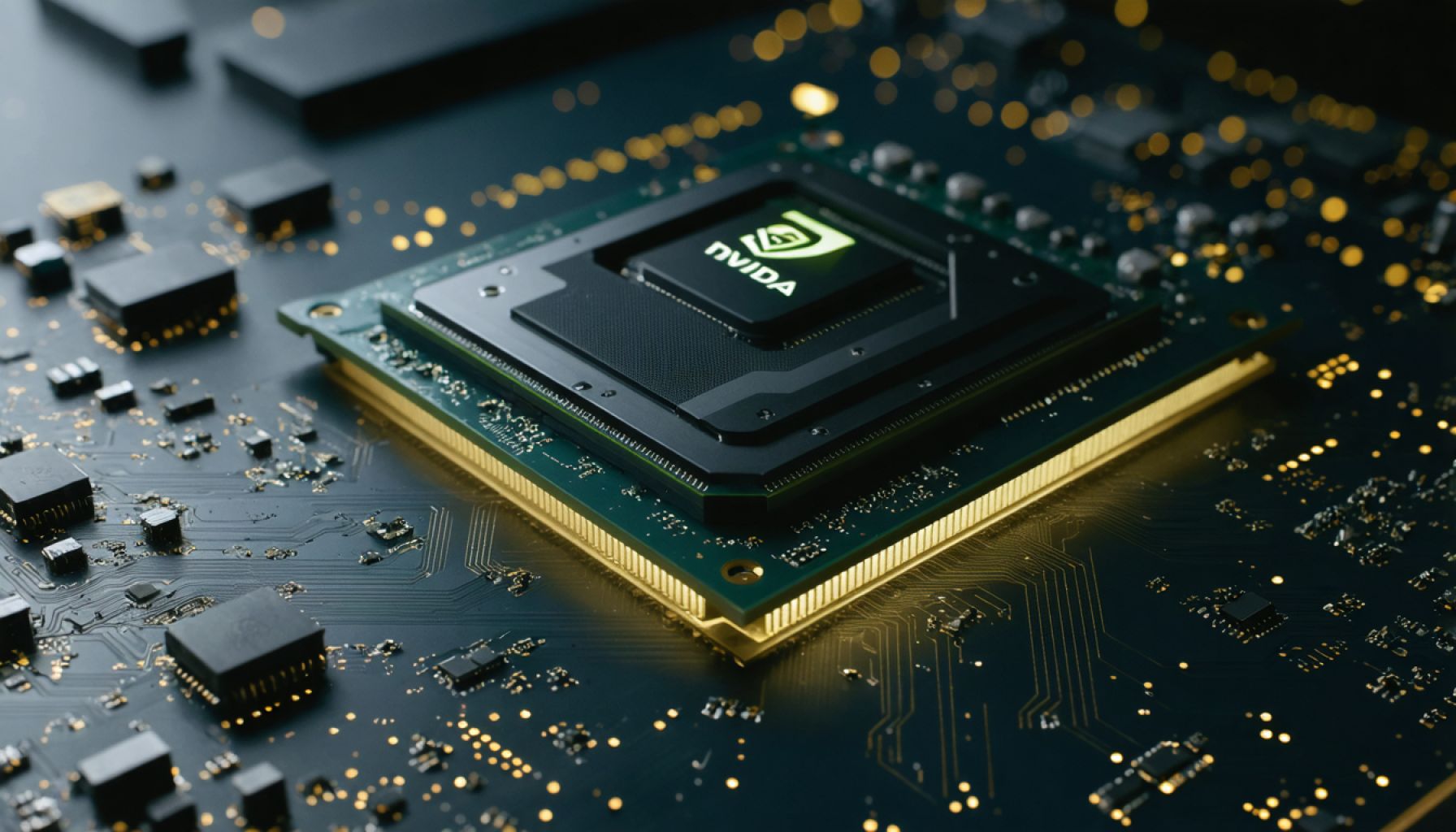- Amid market volatility, Nvidia faces challenges due to China’s DeepSeek unveiling a low-cost large language model.
- Nvidia’s GPU demand for AI might be questioned, but industry leaders like Amazon and Meta continue to bet heavily on Nvidia’s technology.
- Amazon’s $100 billion infrastructure investment relies on Nvidia’s H100 GPUs, especially for AWS cloud and AI services.
- Meta increases capital expenditure to enhance AI capabilities, with a significant dependence on Nvidia-powered clusters.
- Nvidia dominates the AI chip market with a 70% to 95% share, crucial to major tech companies’ AI advancements.
- Beyond AI, Nvidia’s gaming and automotive sectors show strong revenue growth and potential in autonomous vehicles.
- Despite initial concerns, Nvidia’s adaptability and industry-wide AI integration favor long-term growth and investment appeal.
Amid sharp market volatility in early 2025, Nvidia finds itself navigating turbulent waters after China’s DeepSeek unveiled a cutting-edge large language model built at a surprisingly low cost. This development has cast shadows of doubt on future demand for Nvidia’s highly sought-after graphics processing units (GPUs), crucial for AI research. Investors watched apprehensively as Nvidia’s shares, which previously soared over 800% within two years, took a dip. Yet, behind the noise lies a robust undercurrent of opportunity.
The landscape remains promising for Nvidia’s AI chip business, with major industry players like Amazon and Meta reinforcing the narrative. Amazon, a key Nvidia partner, is propelling forward with a tech infrastructure spend of $100 billion in 2025. Spearheading developments in cloud and AI services, Amazon relies heavily on Nvidia’s H100 GPUs, especially within its Amazon Web Services. With Nvidia’s Blackwell computing platform on the horizon, Amazon’s technological appetite only grows.
Meta Platforms is in parallel motion, elevating its capital expenditure to up to $65 billion this year. The quest to enhance AI capabilities is leading Meta to expand its Nvidia H100-powered clusters exponentially. Dominating an estimated 70% to 95% share of the AI chip sphere, Nvidia remains crucial to Meta’s expansive vision.
Beyond data centers, Nvidia’s prowess extends into burgeoning domains. Its gaming sector has rebounded impressively, with significant revenue spikes showcasing renewed interest. Notably, Nvidia’s automotive ventures, including partnerships with automobile innovators, reveal a promising trajectory in the autonomous vehicle field.
Despite DeepSeek’s low-cost AI model raising initial concerns, innovation-driven rapid adaptation in the AI ecosystem heralds potential growth for Nvidia. Investors cognize the short-term uncertainty but should also heed Nvidia’s positioning as an enduring force in AI evolution. As more industries incorporate AI, Nvidia’s strengths and expanding market reach affirm its place as a compelling investment in an era driven by technology.
Nvidia’s Resilience Amidst Market Volatility: What You Need to Know
How-To Steps & Life Hacks
For investors and tech enthusiasts looking to navigate the AI-driven landscape, understanding Nvidia’s strategic positioning involves several key insights:
1. Follow Strategic Partnerships: Monitor Nvidia’s collaborations with industry giants like Amazon and Meta to gauge future demand for AI hardware.
2. Stay Informed on Product Roadmaps: Keep an eye on upcoming releases such as Nvidia’s Blackwell computing platform, which could signal shifts in market dynamics.
3. Diversify Investments: Consider a diversified portfolio that includes tech infrastructure along with AI to mitigate risks associated with market fluctuations.
Real-World Use Cases
Nvidia’s GPUs are pivotal in numerous applications beyond traditional data centers:
– AI Research & Development: Deep learning models rely heavily on Nvidia’s GPUs for training complex algorithms.
– Autonomous Vehicles: Nvidia’s DRIVE platform, which partners with companies like Mercedes-Benz, enhances self-driving technology development.
– Healthcare Sector: AI-powered diagnostic tools use Nvidia technology to improve patient outcomes and reduce diagnostic times.
Market Forecasts & Industry Trends
According to a Gartner report, the AI hardware market is poised to grow exponentially, with Nvidia expected to maintain a dominant position due to continued advancements and strategic partnerships. Demand for AI-driven solutions in sectors like healthcare, automotive, and finance will likely serve as growth catalysts.
Reviews & Comparisons
When comparing Nvidia to competitors like AMD and Intel:
– Performance: Nvidia chips are often superior in handling AI computations, offering higher parallel processing capabilities.
– Market Share: Nvidia maintains a significant lead with an estimated 70% to 95% market share in AI chips.
– Innovation Pace: Nvidia’s frequent updates and new product releases give it a competitive edge in capturing cutting-edge market segments.
Controversies & Limitations
Despite Nvidia’s market presence, potential challenges include:
– Supply Chain Issues: Global chip shortages can affect production timelines and availability.
– Competitive Pressures: Emerging companies like DeepSeek may introduce competitive pricing pressures that Nvidia needs to counter with innovation.
Features, Specs & Pricing
– H100 Tensor Core GPUs: These high-performance GPUs are designed for AI workloads, offering unprecedented speed and efficiency.
– Price Range: Nvidia GPUs can vary widely in price, with high-end models like the A100 and H100 catering to enterprise needs while other models address consumer markets.
Security & Sustainability
Nvidia is committed to sustainability with programs aimed at reducing carbon footprints through energy-efficient GPU designs. Security is also paramount, as advances in hardware encryption and secure boot features protect data center operations.
Insights & Predictions
Experts predict that Nvidia’s strategic focus on AI will continue to drive revenue growth, despite competition and market volatility. Expansion into AI-related domains such as autonomous vehicles and healthcare solidifies its foundational market presence.
Tutorials & Compatibility
Nvidia provides resources for developers through portals like NVidia Developer, offering tutorials on CUDA programming for AI applications. Compatibility with popular frameworks like TensorFlow and PyTorch enhances Nvidia’s usability across H100 GPU clusters.
Pros & Cons Overview
Pros:
– Market dominance with a wide-ranging product lineup
– Strong alliances with tech giants like Amazon and Meta
– Continuous innovation driving product advancement
Cons:
– Vulnerability to competitive pricing pressures
– Susceptibility to global supply chain disruptions
Actionable Recommendations
1. Monitor Global Trends: Stay informed about global technological and economic trends that might impact Nvidia’s market position.
2. Evaluate AI Advancements: Continuously evaluate Nvidia’s advancements in AI to determine investment viability.
3. Leverage Developer Resources: Utilize Nvidia’s tools and tutorials for developing AI applications or integrating Nvidia technology into existing operations.
For the latest industry updates and products, explore the official Nvidia website.














